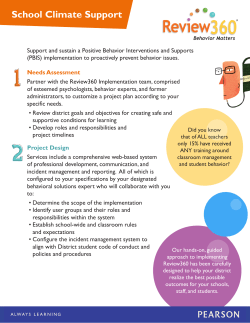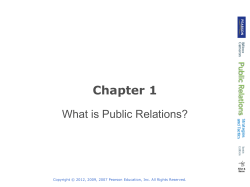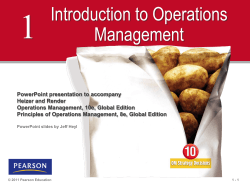
International Business Environments and Operations, 13/e Global Edition
International Business Environments and Operations, 13/e Global Edition Part Five Global Strategy, Structure, and Implementation 11-1 Copyright © 2011 Pearson Education Chapter 11 The Strategy of International Business 11-2 Copyright © 2011 Pearson Education Chapter Objectives • To identify how managers develop strategy • To examine industry structure, firm strategy, and value creation • To profile the features and functions of the value chain framework • To assess how managers configure and coordinate a value chain • To explain global integration and local responsiveness • To profile the types of strategies firms use in international business 11-3 Copyright © 2011 Pearson Education The Role of Strategy in International Business 11-4 Copyright © 2011 Pearson Education Industry, Strategy ,and Firm Performance • Industry organization paradigm leading strategy perspectives • The exceptions of imperfect competition • The idea of industry structure: The Five Forces Model 11-5 Copyright © 2011 Pearson Education Five Forces Model 11-6 Copyright © 2011 Pearson Education Industry Change Industry structure changes because of events like • Competitors’ moves • Government policies • Changes in economics • Shifting buyer preferences • Technological developments • Rate of market growth 11-7 Copyright © 2011 Pearson Education Strategy and Value • Strategy helps managers assess the company’s present situation, identify the direction the company should go, and determine how the company will get there. • Creating Value – Cost Leadership – Differentiation 11-8 Copyright © 2011 Pearson Education The Firm as Value Chain • What is the value chain? • Using the value chain – – – – – – – Configuration Macro Cost Factors Cluster Effects Logistics Digitization Economies of Scale Business Environment 11-9 Copyright © 2011 Pearson Education Coordination • • • • • Coordination Concerns National Cultures Learning Curve Operational Obstacles Subsidiary Networks 11-10 Copyright © 2011 Pearson Education Change and the Value Chain • The configuration and coordination of value chains respond to changes in customers, competitors, industries, and environments. • Caveat: The Risk of Strategy 11-11 Copyright © 2011 Pearson Education Global Integration versus Local Responsiveness • Pressures for Global Integration – Globalization of Markets – Efficiency Gains of Standardization • Pressures for Local Responsiveness – Consumer Divergence – Host Government Policies 11-12 Copyright © 2011 Pearson Education When Pressures Interact The Integration-Responsiveness grid helps managers measure the global and local pressures that influence the configuration and coordination of their value chains. 11-13 Copyright © 2011 Pearson Education Integration Responsiveness Grid 11-14 Copyright © 2011 Pearson Education Types of Strategy 11-15 Copyright © 2011 Pearson Education Future: What’s New in the World of Strategy Types • • • • • Evolution of the Multinational Corporation Visions of the Future The “Metanational” Company “Micro-Nationals” The “Cybercorp” 11-16 Copyright © 2011 Pearson Education All rights reserved. No part of this publication may be reproduced, stored in a retrieval system, or transmitted, in any form or by any means, electronic, mechanical, photocopying, recording, or otherwise, without the prior written permission of the publisher. Printed in the United States of America. 11-17 Copyright © 2011 Pearson Education
© Copyright 2025





















